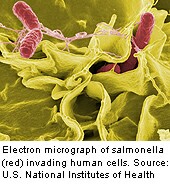Salmonella, Campylobacter show significant resistance in humans and animals
TUESDAY, March 3, 2015 (HealthDay News) — Resistance to commonly used antimicrobials is increasing in Salmonella and Campylobacter, according to a report published Feb. 26 by the European Food Safety Authority (EFSA).
The EFSA and the European Centre for Disease Prevention and Control (ECDC) used similar criteria to interpret data relating to antimicrobial resistance in humans, animals, and foods.
According to the report, in Salmonella, resistance to commonly used antimicrobials was frequently detected and reports of multidrug resistance were high (31.8 percent in humans, 56 percent in broilers, 73 percent in turkeys, and 37.9 percent in fattening pigs). In humans and animals, resistance to commonly used antimicrobials in Campylobacter isolates was frequently detected, with resistance to ciprofloxacin particularly high in humans. More than half of both human and broiler isolates were resistant in Campylobacter jejuni. In Salmonella, levels of co-resistance to critically important antimicrobials were low (0.2 percent in humans, 0.3 percent in broilers, and 0 percent in turkeys and pigs). Low-to-moderate levels of multidrug resistance and co-resistance to critically important microbials were reported in Campylobacter isolates in animals; low levels were reported in humans.
“Such high resistance levels reduce the effective treatment options for severe human Campylobacter infections,” Mike Catchpole, Ph.D., chief scientist at the ECDC, said in a news release issued by the EFSA.
Copyright © 2015 HealthDay. All rights reserved.








